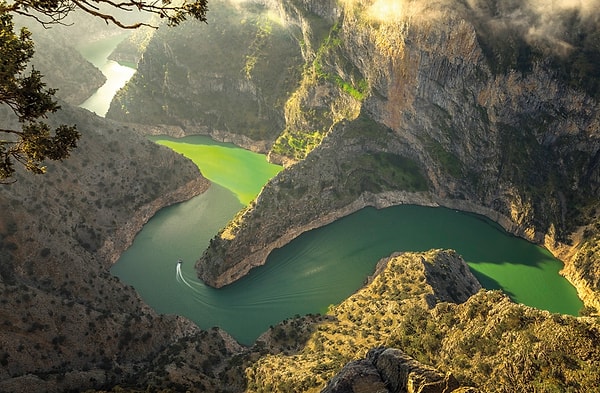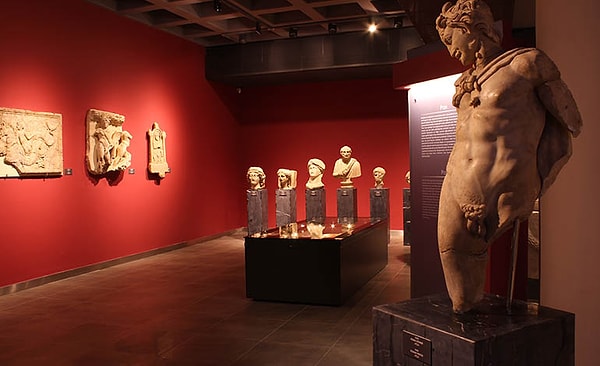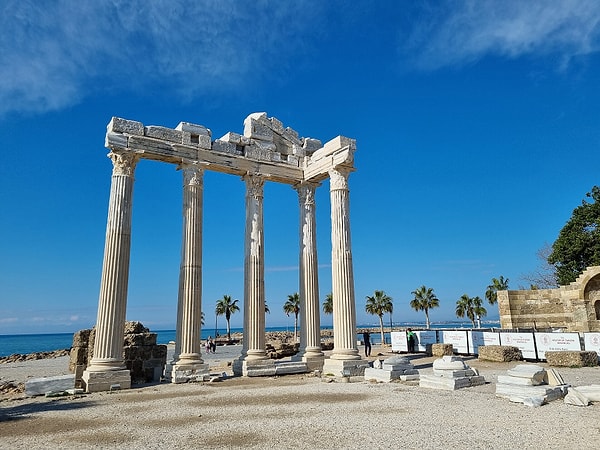What Is Aydin Famous For? Discover the Highlights of This Aegean Gem
Located in the heart of the Aegean Region, Aydin is one of Turkey's most impressive cities, celebrated for its historical richness, natural beauty, traditional way of life, and hospitable people. An important settlement centre since ancient times, Aydin is situated on the fertile Büyük Menderes Plain. It offers an unforgettable experience to visitors with its coasts extending to the Aegean Sea, hills adorned with olive groves, ancient cities, and unique cuisine. So, what is Aydin known for? What to do in Aydin? What to eat in Aydin? And what to see in Aydin? Let's explore together👇
History of Aydin: From Antiquity to the Republic

Aydin's history dates back to the 7th century BC. The city was influenced by the Carian, Ionian, and Lydian civilisations in ancient times. Aydin has been an intellectual centre throughout history, particularly due to the Ionian contributions to science, art, and philosophy. Cities such as Miletus, Priene, and Nysa are carriers of the cultural and architectural richness of this era.
During the Roman period, Aydin (Tralleis) gained significant importance due to its location on trade routes. While it became one of the religious centres during the Byzantine era, it came under Seljuk rule in the 12th century and then the Ottomans in the 15th century. During the Ottoman period, particularly in the 18th and 19th centuries, Aydin became a province renowned for its productive agriculture, exports, and Efelik culture.
Historical Places to Visit in Aydin

- Aphrodisias Ancient City (Karacasu)
Aphrodisias, a UNESCO World Heritage Site, is named after Aphrodite, the goddess of love and beauty. It is one of the most significant centres of the ancient world, particularly in the field of sculpture. Structures such as the Temple of Aphrodite, Sebasteion, stadium (the largest in the ancient world, with a capacity of 30,000 people), theatre, and Agora still stand in the city. The Aphrodisias Museum, also located in the city, exhibits sculptures uncovered during excavations.
- Nysa Ancient City (Sultanhisar)
Nysa, one of the leading educational centres of Anatolia during the Roman era, is especially noted for its ancient library. The city's theatre accommodates approximately 12,000 people. Ancient tunnels, stadium, and agora structures are also worth visiting.
- Ancient City of Miletus and Ilyas Bey Complex (Didim)
Miletus is a city where scholars such as Thales were born and where the foundations of philosophy and mathematics were established. The Theatre of Miletus is an impressive 15,000-seat structure from the Roman era. The nearby Ilyas Bey Complex, constructed in 1404 during the Menteşeoğulları Principality, is one of the valuable examples of pre-Ottoman early Turkish architecture.
- Ancient City of Priene (Soke)
Priene is significant as an ancient Ionian city where the grid city plan known as the Hippodamos plan was implemented. The Temple of Athena, the Buleuterion (assembly building), and the theatre are among the well-preserved ancient structures. Although the city has retreated from the sea, the view and atmosphere are captivating.
- Didyma and the Temple of Apollo
The Temple of Apollo is one of the largest oracle centres of the ancient world. The temple boasts 122 columns, each 20 metres high. The adyton section of this structure in Didyma, a sacred space where prophecies were delivered, is quite impressive.
Natural Beauties and Ecotourism Spots

- Arapapıştı Canyon (Bozdogan)
Arapapıştı Canyon, formed under the waters of the Kemer Dam, stretches along the borders of Aydin, Denizli, and Muğla. Rock tombs, ancient ruins, and natural caves can be explored through boat tours organised along the canyon. The canyon area is also suitable for paragliding and trekking.
- Cave of Zeus (Kusadasi)
Located at the entrance of Dilek Peninsula-Büyük Menderes Delta National Park, this cave is where, according to mythology, the god Zeus hid from the wrath of Poseidon. The cool water within is favoured for both swimming and picnic breaks.
- Lake Bafa and Latmos Mountains
Lake Bafa begins at the borders of the Söke district in Aydin and extends towards Muğla. The surroundings of the lake are home to the ruins of the ancient city of Herakleia, rock paintings, and Byzantine monasteries. History and nature intertwine during walks in the Latmos Mountains.
- Dilek Peninsula-Büyük Menderes Delta National Park (Güzelçamlı)
This national park is one of the richest in biodiversity in Turkey. It is home to species such as the caracal, wild boar, and otter. The park features hiking routes, beaches, and bird-watching areas.
Source: 35 Punto
Prominent Districts of Aydin

- Kusadasi
Kuşadası, a significant cruise port in the Aegean, draws a multitude of local and international tourists during the summer months. It is distinguished by its Güvercinada Castle, Women's Sea, Davutlar beaches, and vibrant nightlife. It is also well-developed in shopping and gastronomy.
- Didim
Altınkum Beach is an ideal holiday destination for families, boasting clear waters and a shallow structure. It also stands out for its cultural tourism, thanks to the Temple of Apollo and the ancient sites in its vicinity.
- Karacasu
In addition to Aphrodisias, Karacasu is notable for its villages where traditional Yoruk culture is preserved. It is a perfect region for those wishing to experience handicrafts, local weaving products, and natural life.
- Çine
Çine is known for its olive groves, promenade areas along the banks of the Çine Stream, and famous Çine meatballs. It appeals to those seeking a tranquil holiday intertwined with nature.
Cultural and Historical Heritage Sites

- Aydin Archaeology Museum (Efeler)
The museum displays artefacts excavated from ancient cities such as Aphrodisias, Nysa, and Tralleis. Visitors can view sarcophagi, bronze statues, marble busts, coins, and mosaics.
- Yörük Ali Efe Museum (Yenipazar)
The home of Yörük Ali Efe, one of the heroes of the War of Independence, has been restored and converted into a museum. The museum showcases Efe's personal belongings, documents from the period, and local attire.
- Cihanoğlu Complex (Efeler)
Constructed in 1756 by Cihanoğlu Mehmed Bey, the complex comprises a mosque, madrasah, and bathhouse. It stands as one of the few examples of Ottoman architecture with Baroque influences in Aydin.
- Oleatrium Olive and Olive Oil History Museum (Kuşadası)
The museum, where olive oil production techniques from ancient times to the present day are explained, introduces olive oil culture in 11 halls. It also provides mythological information about olives.
Source: Müzekart.org
Transportation and Accommodation in Aydin

Aydin is easily accessible by road from neighbouring provinces such as İzmir, Denizli and Muğla. Thanks to the railway network, districts such as Nazilli and Söke can also be reached by train. The nearest airport is Izmir Adnan Menderes Airport (approximately 1.5 hours away).
Hotels, hostels and boutique accommodation options are common in coastal towns such as Kuşadası, Didim and Davutlar. Business hotels and apartments are available in the city centre.
Aydin Cuisine: The Heart of Aegean Flavours

Aydin cuisine is based on olive oil and natural products. The main flavours are as follows:
Çöp Şiş: Tiny pieces of meat cooked over a charcoal fire, especially famous in Germencik.
Keşkek: Indispensable for wedding and holiday tables. It is prepared by beating wheat and meat for a long time.
Artichoke and Cowpea Salad with Olive Oil: Typical Aegean olive oil dishes made with fresh spring vegetables.
Fig Dessert: Prepared with Aydin figs, this dessert is both natural and energising.
Gypsy Pilaf: A light salad prepared with green onions, tomatoes, parsley and lemon.
🎉 Festivals and Events in Aydin

Aydin reflects its culture and social life to its visitors with colourful festivals organised throughout the year. These events offer both the opportunity to be immersed in the local community and to gain a deeper understanding of the region's richness.
Aydin Agriculture, Culture and Art Festival (Efeler): Organised every year in September, this festival aims to promote Aydin's agricultural production power and cultural diversity. It is quite colourful with folk dances, exhibitions, panels and local product stands.
International Karacasu Aphrodisias Culture, Art and Promotion Festival: The festival, organised every year in August in Karacasu, contributes to the promotion of the ancient city of Aphrodisias, a UNESCO World Heritage Site. It is full of handicraft exhibitions, Yoruk migration reenactments and concerts.
Didim Altinkum Writers Festival: Held in July, this festival brings together writers and readers from all over Turkey. It appeals to literature lovers with book signings, days and interviews.
Kuşadası Youth Festival: This event, organised with beach concerts in Kuşadası during the summer months, is one of the largest open-air music festivals in Turkey. It attracts great interest from young people.
Source: Nerdenerede
🧶 Local Handicrafts and Shopping

Aydin offers both authentic shopping and a cultural experience with its traditional production culture and natural products. These products can be found in the neighbourhood markets and producer stands in the districts.
Nazilli Cloth: This soft-textured cotton fabric is produced with traditional methods. It is still produced by hand labour on weaving looms in and around Nazilli.
Aydin Fig: Turkey's and the world's highest quality dried figs are grown in Aydin. Especially the Sarılop variety is of export quality. Fig paste, jam and Turkish delight are also very famous.
Olive Oil and Olive Products: There are boutique olive oil producers in Koçarlı, Germencik and Söke districts. Early-harvest, cold-pressed olive oils and natural olive soaps are preferred as souvenirs.
Ceramics and Basket Weaving: Traditional handcrafted ceramic and basket products are sold especially in Kuşadası and its surroundings. These products are both decorative and functional.
🏞️ Hidden Villages and Alternative Routes

Villages outside the tourist centres are ideal for those looking for quiet and authentic experiences in touch with nature.
Yaylalı Village (Bozdoğan): Yaylalı, one of the high-altitude regions of Aydin, attracts attention with its cool weather and natural life in summer. It is possible to walk among peach and apple orchards.
Argavlı Village (Sultanhisar): In this village, which maintains organic agriculture and traditional village life, it is possible to buy local products directly from the producers. Visitors can start the day with natural breakfasts in the village.
Old Doğanbey Village (Söke): Situated at the foot of the Dilek Peninsula, this stone-built village boasts some of the most beautiful examples of ancient Greek architecture. It makes you time travel with its restored houses, quiet streets and historical texture.
Source: Söke Belediyesi
⛺ Camping and Caravan Sites

For travellers seeking solitude with nature, Aydin offers numerous options for camping and caravan routes.
Dilek Peninsula National Park (Kuşadası): The campgrounds in the park are located on the seafront and surrounded by natural shaded areas. Camping is available with a daily entrance.
Bafa Lake Campgrounds: There are suitable grounds for caravan and tent camping in the areas located on the lake. Camping by the lake while watching the stars is an unforgettable experience.
Plateau Camp (Bozdoğan-Yaylalı): It is preferred especially in summer months with its clean air, abundant oxygenated nature and cool climate. Nature walks can be done in forested areas.
🏛️ Mythological Stories and Legends

The ancient cities of Aydin are of great importance not only archaeologically but also mythologically. These legends increase the meaning and mystery of the places visited.
Temple of Apollo (Didyma): In the temple, known as the centre of prophecy, the priests of the god Apollo would make prophecies. People used to flock to this sacred place to learn their fate.
Latmos Mountains and the Legend of Endymion: According to mythology, the Moon Goddess Selene fell in love with the shepherd Endymion, who was mesmerised by her beauty. When the gods granted him eternal sleep, Selene came to visit him every night. This legend adds depth to the mysterious atmosphere of Latmos.
Cave of Zeus (Kusadasi): Rumour has it that Zeus hid in this cave to escape the wrath of his brother Poseidon. With its cold water and hidden location, the cave still bears traces of the legend.
Keşfet ile ziyaret ettiğin tüm kategorileri tek akışta gör!

Send Comment